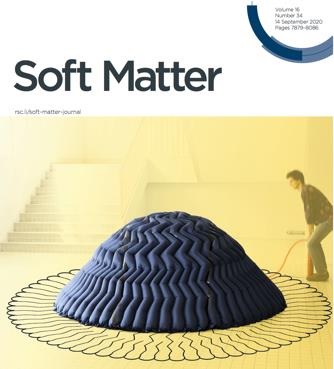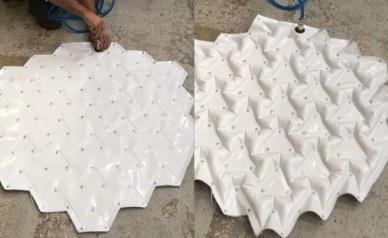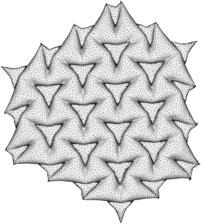PhD Position : Design and fabrication of an inflatable architectured shell at the civil engineering scale
While inflatables of complex 3D shapes can be obtained by assembling carefully designed panels, their fabrication generally requires significant manual intervention as the pieces of the inflatables need to be non-trivially aligned before they are sewn or sealed to each other. When deflated, such structures are notoriously difficult to fold. In contrast, inflatables made of tubular chambers are simpler to fabricate and easy to roll or fold for storage or transportation as they are planar when deflated. However, the high anisotropy of the tubular pattern limits the space of shapes that can be reproduced as well as the strength of the final shell structure. Recent work by members of the consortium showed that it is still possible to program 3D inflatables by playing with the alignment of the tubes (see inset figure). However, these techniques are in practice still limited to a narrow range of axisymmetric shapes despite advances in the geometrical description of the problem. More importantly, the resulting inflatables suffer from poor bending stiffness and limited strength. This stiffness issue limits the use of these inflatable structures for practical applications, as structural rigidity is generally required for the object to be functional.
MatAIRials project tackles these limitations and aims at developing novel tools to easily design and fabricate free-form inflatable shells able to carry external loadings.
The main objectives of the project can be defined as follows:
- Ease of fabrication: The 3D structures will be made of superimposed planar membranes sealed according to a given welding pattern, a process that can be easily upscaled and automated.
- Ease of design: The optimal welding pattern should be obtained automatically, i.e., through numerical computation, and propose a numerical tool that can be incorporated into a complete and fully automated design pipeline, from user-specifications to confection details which will be made available to the architecture and designer community.
- Functionality: A demonstration will be made that the proposed methods can be used for fabricating functional objects (here, able to carry loads). This will be achieved via the fabrication of two types of demonstrators: typically, a functional medical orthosis (small-scale application) and an inflatable formwork (civil engineering application) which is the goal of the present PhD proposal.
To reach these objectives, locally periodic welding patterns, inspired by Origami, will be investigated and the resulting inflated pad will be treated as a meta-material (i.e., an architectured material) whose geometric (metric and curvature changes) and mechanical properties (membrane and bending stiffnesses and strength) will be characterized. Tiling these patterns on the inflatables and adjusting their parameters should then allow to play with the local in-plane contraction of the pad and in turn to control its final 3D shape. Indeed, following a fundamental result from differential geometry, surfaces undergoing non-uniform metric changes become 3D.
Civil engineering applications of inflatables shells
Main Goal of the PhD
There are numerous civil engineering applications of inflatable4. Most of them are dedicated to temporary shelters and they may be divided into two classes. The first class is the assembly of tubular chambers5,6. This simple design relies on high internal pressure and can sustain significant loads. However, the overall shape of the tube assembly remains limited and its mechanical behavior is highly anisotropic. The second class is made of a single membrane which encompasses the interior space and is inflated by a small overpressure. The geometry of these membranes is limited to surfaces of constant mean curvature, a broader family of surfaces including bubble-like shapes. However, these membranes require complex assemblies of fabric, cannot carry large loads as the pressure remains limited, and must involve an air-lock entrance together with continuous air pumping.
MatAIRials inflatable structures are original and open a wider range of shapes than these large-scale applications while preserving significant mechanical strength and may be used as a freeform formwork used for casting a concrete shell. Indeed, freeform formworks are notoriously expensive as they require important labor for building the structure itself. They are also not environmentally friendly because they generate a lot of wasted material. With an inflatable structure, setting the formwork in place is simpler and faster. It may also be possible to reuse the inflatable. An historical application of inflatable formwork are Binishells (Figure 2): an almost spherical membrane is inflated and serves as a formwork to create a concrete dome. Nevertheless, this application is confined to domes and an objective is to investigate a broader family of shapes that could be prefabricated in order to industrialize the construction and lower the cost.
The present PhD aims at validating the practical interest of MatAIRials inflatables and the usability of the numerical pipeline implemented in the project for designing and fabricating large-scale free-form structures (25 m²) in the context of civil-engineering applications, such as lightweight formworks. More specifically, the main goal of the present PhD is to identify and address specific challenges related to effects that become critical at large scale (e.g., gravity, high membrane tension and stiffness) and to propose adaptations to the numerical tools/models, as well as to the fabrication processes so that structures of this size can be handled in practice.
Detailed scientific program of the PhD
The PhD candidate will design and fabricate a 25m² inflatable structure using the tools developed by partners of the MatAIRials project and study the effects of gravity, high membrane tension and stiffness, that are critical at this scale. Practical approaches for fabrication, such as welding technology and material selection will be investigated, as well as mitigation strategies for reinforcement (inclusion of flexible rods). The main application foreseen is lightweight formwork, for whi elastic gridshells8 have already been applied but have limited achievable sur focus also on the potential of industrialization of the process to lower its cost.
Mechanical testing and structural upscaling
Diverse materials will be selected using Ashby’s method according to the span and load. These materials will be tested on uniaxial tensile tests and on simple components in 3 points flexural test. Due to the envisioned scale, it is likely that fiber-reinforced fabric will be used. This involves orthotropy at the material scale which may be easily taken into account in our simulations.
The testing and numerical simulations on simple structures (domes, cylinder) will be used to determine the potential of scalability of inflatables, depending on material properties, inner pressure, and external load.
Design workflow for architectural design with inflatables
After the scalability study, a relevant scale for implementation will be selected. The PhD candidate will further investigate the definition of relevant design parameters (overall shape, pattern topology and dimension, pressure of formwork, additional falsework, concrete formulation, foundation) and performance metrics (strength, deflection, life cycle assessment (LCA)) in the context of civil or architectural engineering. Since a practical design is often the result of compromise between various objectives, the design procedure will implement a multi-criteria optimization procedure and investigate the possibility to generate a Pareto front using on-the-shelf evolutionary algorithms9 that would help the designer to decide on the “optimal” design. The homogenized model obtained by MatAIRials partners will be used. The design will also focus on the potential of prefabrication of the elements to produce the structure in a workshop and then transported to site. This solution will help to better control the atmospheric conditions for the inflation and spraying the concrete.
Construction and structural test of the 25m² prototype
This part will be dedicated to the full-scale experimentation of an inflatable structure used as a lightweight formwork. The main challenge regarding the membrane fabrication is the automation of welding patterns. We will develop a prefabrication strategy for automation based on the lab expertise on construction automation: mobility of robots10 and quality control through appropriate sensor (force sensor or computer vision) will be addressed.
The second challenge is the sequencing of the concrete spraying, which should limit the strains in the fresh concrete that is deposited on the inflatable structure. This sequencing optimization will rely on structural analysis tools developed by the partners, as well as slicing optimization strategies developed for 3D printed structures, which is an area of expertise of Laboratoire Navier11. An in situ concrete test will be developed to check that the strength of the concrete on-site will be close to the one calculated in the design stage. Structural tests will be performed with symmetrical and unsymmetrical loading for the formwork and the resulting concrete shell. For each load case, the deflection of the structure will be done with accurate measurement from high frequency cameras.
Life cycle analysis
A Life cycle analysis (LCA) will have been performed during the preliminary design to help to choose a group of or select the most appropriate solutions. This LCA will be based on midpoint indicators with their uncertainty. A second life cycle analysis will be performed a posteriori based on the results of construction. This will allow the designer to compare the real solution to the designed solution. A comparison with other traditional solutions will be made to conclude on the potential reduction of the environmental impact of such solutions.






